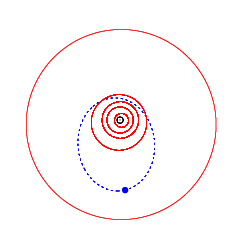1036 Ganymed
 | |
| Discovery | |
|---|---|
| Discovered by | W. Baade |
| Discovery date | October 23, 1924 |
| Designations | |
| Pronunciation | /ˈɡænɨmɛd/ |
| Named after | Ganymede |
| Alternative names | 1924 TD; 1952 BF; 1954 HH |
| Minor planet category |
Amor III asteroid, Mars-crosser asteroid |
| Orbital characteristics | |
|
Epoch October 22, 2004 (JD 2453300.5) | |
| Aphelion |
4.091 AU (611.961 Gm) |
| Perihelion |
1.233 AU (184.434 Gm) |
| Semi-major axis |
2.662 AU (398.198 Gm) |
| Eccentricity | 0.537 |
| Orbital period |
4.34 a (1586.202 d) |
| Average orbital speed | 16.86 km/s |
| Mean anomaly | 152.459° |
| Inclination | 26.644° |
| Longitude of ascending node | 215.699° |
| Argument of perihelion | 132.429° |
| Physical characteristics | |
| Dimensions |
34.28 ± 1.38[1] km 31.66[2] km |
| Mass | (1.67 ± 3.18) × 1017[1] kg |
| Mean density | 7.9 g/cm3 |
| Equatorial surface gravity | 0.0089 m/s² |
| Escape velocity | 0.0168 km/s |
| Rotation period | 10.31[2] h |
| Albedo | 0.17 [3] |
| Temperature | ~160 K |
| Spectral type | S (VI) [4][5] |
| Apparent magnitude | 8.1 [6] |
| Absolute magnitude (H) | 9.45 |
|
| |
1036 Ganymed is the largest near-Earth asteroid, at about 32–34 km in diameter. It was discovered by Walter Baade on October 23, 1924. It has a very well determined orbit, and its next pass of the Earth will be at a distance of 0.374097 AU (55,964,100 km; 34,774,500 mi) on 13 October 2024.[7] It is an Amor asteroid, and also a Mars-crosser asteroid, and will pass 0.02868 AU (4,290,000 km; 2,666,000 mi) from Mars on 16 December 2176.[7]
Name
Ganymed is the German spelling of Ganymede, the Trojan prince turned god whom Zeus designated the cupbearer to the Greek gods. Jupiter's moon Ganymede is named after the same, but uses the English spelling.
Physical characteristics
Owing to its early discovery date, Ganymed has a rich observational history. A 1931 paper published the absolute magnitude, based on observations to date, as 9.24,[8] slightly brighter than the present value of 9.45. Ganymed is an S-type asteroid, meaning that it is relatively reflective and composed of iron and magnesium silicates. Spectral measurements put Ganymed in the S (VI) spectral subtype, indicating a surface rich in orthopyroxenes, and possibly metals (although if metals are present they are covered and not readily apparent in the spectra).[4]
In 1998, radar observations of Ganymed by the Arecibo radio telescope produced images of the asteroid, revealing a roughly spherical object.[9] Also around this time a study of several asteroids' visual lightcurves (variation of light intensity over time) and polarization curves was conducted (the data for Ganymed is limited due to poor weather at the time). The study concluded that there was a weak correlation between the lightcurve and polarimetry curve as a function of rotation angle.[10] Because polarization is dependent on surface terrain and composition, rather than the observed size of the object like the lightcurve, this suggests that the surface features of the asteroid are roughly uniform over its observed surface.[10]
More recent observations of Ganymed's lightcurve, reported in 2007, confirm a rotation period of 10.314 ± 0.004 h and a lightcurve amplitude of 0.12 mag.[11]
An occultation of a star by Ganymed was observed from California on August 22, 1985.
References
- ↑ 1.0 1.1 Carry, B. (December 2012). "Density of asteroids". Planetary and Space Science 73: 98–118. arXiv:1203.4336.pdf. Bibcode:2012P&SS...73...98C. doi:10.1016/j.pss.2012.03.009. See Table 1.
- ↑ 2.0 2.1 1036 Ganymed at the JPL Small-Body Database
- ↑ Database of Near-Earth Asteroids
- ↑ 4.0 4.1 Fieber-Beyer, S. K.; Gaffey, M. J.; Abell, P. A.; Reddy, V. (March 12–16, 2007). "Mineralogical Characterization of Near Earth Amor Asteroid 1036 Ganymed". 38th Lunar and Planetary Science Conference 1388: 1695. Bibcode:2007LPI....38.1695F.
- ↑ http://spiff.rit.edu/richmond/parallax/phot/LCSUMPUB.TXT
- ↑ Donald H. Menzel and Jay M. Pasachoff (1983). A Field Guide to the Stars and Planets (2nd ed.). Boston, MA: Houghton Mifflin. p. 391. ISBN 0-395-34835-8.
- ↑ 7.0 7.1 "JPL Close-Approach Data: 1036 Ganymed (1924 TD)". 2012-01-10 last obs. Retrieved 2012-01-15.
- ↑ Putilin, J. (July 1931). "Brightness of the minor planet 1036 Ganymed". Astronomische Nachrichten 242 (11): 213–216. Bibcode:1931AN....242..213P. doi:10.1002/asna.19312421104.
- ↑ "1036 Ganymed Radar Images".
- ↑ 10.0 10.1 Nakayama, Hiroyuki; Fujii, Yasumasa; Ishiguro, Masateru; Nakamura, Ryosuke; Yokogawa, Sozo; Yoshida, Fumi; Mukai, Tadashi (July 2000). "Observations of Polarization and Brightness Variations with the Rotation for Asteroids 9 Metis, 52 Europa, and 1036 Ganymed". Icarus 146 (1): 220–231. Bibcode:2000Icar..146..220N. doi:10.1006/icar.2000.6396.
- ↑ Krugly, Yu. N; Gaftonyuk, N. M.; Belskaya, I. N.; Chiorny, V. G.; Shevchenko, V. G.; Velichko, F. P.; Lupishko, D. F.; Konovalenko, A. A.; Falkovich, I. S. (2007). "Kharkiv study of near-Earth asteroids". Proceedings if IAU Symposium 236 (S236): 385–390. doi:10.1017/S174392130700347X. ISBN 978-0-521-86345-2.
Further reading
- Fevig, Ronald A.; Fink, U (May 2007). "Spectral observations of 19 weathered and 23 fresh NEAs and their correlations with orbital parameters". Icarus 188 (1): 175–188. Bibcode:2007Icar..188..175F. doi:10.1016/j.icarus.2006.11.023.
- Hahn, G.; Magnusson, P; Harris, A.W; Young, J.W; Belkora, L.A; Fico, N.J; Lupishko, D.F; Shevchenko, V.G; Velichko, F.P et al. (April 1989). "Physical studies of Apollo-Amor asteroids: UBVRI photometry of 1036 Ganymed and 1627 Ivar". Icarus 78 (2): 363–381. Bibcode:1989Icar...78..363H. doi:10.1016/0019-1035(89)90184-X.
External links
| |||||
| ||||||||||||||||||||||